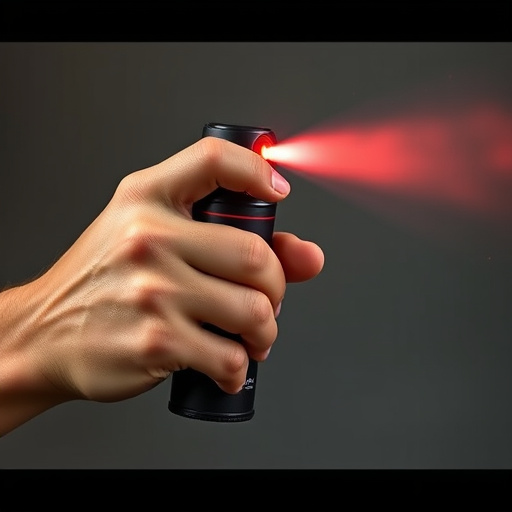Pepper spray's effectiveness varies greatly between indoor and outdoor crowd control scenarios. Outdoors, better ventilation causes quicker but shorter-lived effects, while indoors, reduced airflow traps pepper spray particles, leading to prolonged irritation and evacuation challenges. Strategic deployment demands tailored approaches: heightened caution indoors, proper wind direction analysis outdoors. The debate surrounds health risks, especially for vulnerable individuals and bystanders, prompting exploration of alternatives like foam batons or water cannons for indoor applications.
“Police often rely on pepper spray as a crowd control tool, but its effective use and safety extend beyond mere deployment. This article delves into the world of pepper spray, exploring its application in both indoor and outdoor settings. We compare unique considerations for each environment, dissecting effectiveness and safety protocols. Additionally, we scrutinize potential risks, controversial uses, and emerging non-lethal alternatives to pepper spray. By understanding these aspects, we can facilitate informed discussions on crowd control strategies.”
- Understanding Pepper Spray: A Crowds Control Tool
- Indoor vs Outdoor Applications: Unique Considerations
- Effective Use and Safety Protocols
- Potential Risks and Controversy
- Alternative Strategies: Exploring Non-Lethal Options
Understanding Pepper Spray: A Crowds Control Tool
Pepper spray, also known as oleoresin capsicum (OC) spray, is a crowd control tool that has been in use for decades. It works by irritating the eyes, nose, and respiratory system, causing temporary blindness, coughing, and difficulty breathing. This non-lethal method is designed to disrupt and disperse crowds quickly and safely.
The effectiveness of pepper spray can vary depending on its application and the environment. When used outdoors, where there’s plenty of ventilation, the effects are typically quicker and shorter-lived due to the spread of the spray in the open air. In contrast, indoor use can lead to more prolonged exposure as the spray becomes concentrated in a confined space, posing potential risks to both intended targets and bystanders alike.
Indoor vs Outdoor Applications: Unique Considerations
Pepper spray, a common tool in crowd control, serves different purposes and requires distinct considerations when used indoors versus outdoors. In indoor settings, like arenas or crowded spaces, its effectiveness can be diminished due to reduced airflow and the potential for pepper spray particles to become trapped in enclosed areas. This can lead to longer-lasting irritation for individuals within the space, as well as difficulty in evacuating affected areas safely and swiftly.
Conversely, outdoor applications offer more open environments where air circulation is generally better, aiding in the dispersion of pepper spray. While this may seem like a simple distinction, it underscores the importance of tailoring crowd control strategies to specific locations. Indoor spaces necessitate careful consideration of ventilation systems and potential hiding spots for individuals seeking refuge from the effects of pepper spray, whereas outdoor settings demand attention to wind patterns and terrain that could impact the reach and intensity of the spray.
Effective Use and Safety Protocols
The effective use of pepper spray in crowd control involves a strategic approach tailored to indoor and outdoor settings, highlighting key safety protocols. When deployed outdoors, pepper spray can quickly disperse large gatherings, making it ideal for public events or demonstrations where space is ample. However, indoors, its use requires heightened caution due to confined spaces and potential ventilation challenges.
Safety protocols mandate that officers receive proper training in pepper spray application, including awareness of the wind direction to prevent accidental exposure. In both scenarios, it’s crucial to ensure minimal risk to bystanders and the targeted individuals’ eventual de-escalation and safe removal from the area.
Potential Risks and Controversy
The use of pepper spray as a crowd control measure has sparked significant debate and raised concerns about its potential risks, especially when deployed indoors versus outdoors. While proponents argue that it’s an effective way to quickly disrupt and disperse crowds, critics highlight the severe health implications, particularly in confined spaces. Indoor use can lead to the accumulation of spray in small areas, causing respiratory distress, coughing fits, and even panic attacks for individuals with pre-existing conditions or sensitivity to capsaicin, the active ingredient.
Moreover, the impact on bystanders who are not part of the crowd has been a point of contention. Pepper spray can drift into adjacent spaces, posing risks to innocent people, including children and the elderly, raising questions about its selective application and potential for misuse. This controversy underscores the need for stringent guidelines and careful consideration of alternatives to ensure public safety and mitigate the adverse effects associated with pepper spray use in both indoor and outdoor settings.
Alternative Strategies: Exploring Non-Lethal Options
In recent years, there’s been a growing need for effective yet non-lethal crowd control methods, especially in diverse environments like indoor and outdoor spaces. While pepper spray has long been a standard tool for law enforcement, exploring alternative strategies is crucial, particularly when considering the potential risks and effectiveness of pepper spray in different settings.
For instance, while pepper spray may be suitable for outdoor crowd control due to its ability to disperse quickly into the air, its use indoors can pose significant challenges. The confined spaces and higher concentration of people can lead to longer-lasting effects, causing not only discomfort but also respiratory issues. As such, non-lethal options like foam batons, water cannons, or even less-lethal firearms are being explored for indoor applications. These alternatives aim to de-escalate situations without relying on pepper spray, ensuring safety and minimizing the impact on crowd dynamics in both indoor and outdoor environments.
Pepper spray, while effective for crowd control both indoors and outdoors, comes with potential risks and controversy. Understanding its unique applications in different settings, safe handling protocols, and alternative non-lethal options is crucial. In the context of indoor use, pepper spray’s effectiveness may be diminished due to reduced space and potential ventilation issues, contrasting with outdoor environments where distance and open air can mitigate its impact. As we’ve explored, exploring diverse crowd control strategies allows for more nuanced approaches tailored to specific scenarios, ensuring safety while addressing public gatherings effectively.
